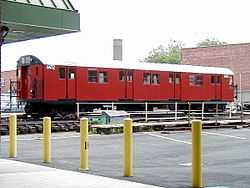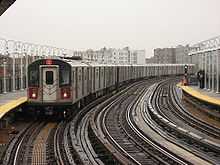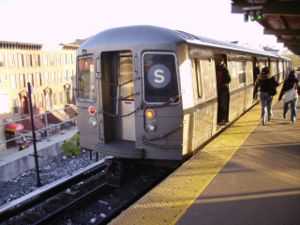R16 (New York City Subway car)
| R16 (New York City Subway car) | |
|---|---|
|
An R16 car on display at the New York Transit Museum | |
|
R16 6452 at P.S. 248, Brooklyn (a NYCT training facility) as a training car in July 2001. This car got replaced by an R110B car and was later scrapped. | |
| Manufacturer | American Car and Foundry, USA |
| Replaced | BMT Zephyr |
| Constructed | 1954-1955 |
| Entered service | 1955 |
| Scrapped |
1983 (GE cars) 1987 (WH cars) |
| Number built | 200 |
| Number preserved | 4 |
| Number scrapped | 196 |
| Formation | Single unit cars |
| Fleet numbers | 6300-6499 |
| Capacity | 70 (seated) |
| Operator | New York City Subway |
| Specifications | |
| Car body construction | LAHT carbon steel |
| Car length | 60 ft (18.29 m) |
| Width | 10 ft (3.05 m) |
| Height | 12.08 ft (3.68 m) |
| Platform height | 3.76 ft (1.15 m) |
| Doors | 8 |
| Maximum speed | 55 mph (89 km/h) |
| Weight | GE cars (6400-6499) 84,532 lb (38,343 kg), WH cars (6300-6399) 86,270 lb (39,131 kg) |
| Traction system |
Westinghouse 1447C; GE 1240A4 Westinghouse UPC631A; GE MCM 17KG113D1 |
| Power output | 100 hp (75 kW) / 4 per car |
| Acceleration | 2.5 mph/s (4.0 km/(h·s)) (?) |
| Braking system(s) | WABCO ME42 SMEE |
| Track gauge | 4 ft 8 1⁄2 in (1,435 mm) |
The R16 was a New York City Subway car manufactured by American Car and Foundry Company from 1954 to 1955 in a kale green paint scheme. The R16s were numbered 6300–6499, and were retired in the late 1970s up through 1983.
History
They were placed into passenger service on January 10, 1955 on the #15, (now J). 50 of the R16 cars (6300-6349) were transferred to the A train in preparation for the opening of the former Long Island Rail Road's IND Rockaway Line on June 28, 1956. This was because the TA wanted to use the newest equipment available at the time.[1] After the late 1950s, the 50 R16s were returned to the BMT Eastern Division and would remain there until the late 1960s and the early 1970s when they were transferred to various lines throughout the system.
The R16s quickly became the new standard in car design for the New York City Transit Authority. Structurally and mechanically, they were the larger versions of the R17s and basically an improved version of the R10s with same exact dimensions except that the R16s had electric door engines while the R10s had the air door engines. When they were new, the R16s gave the R10s competition when it comes to speed as both cars were mechanically similar with four 100 horsepower motors.
The R16, like the older Arnines, R10s, and R11s, features three sets of mid-carbody passenger windows on each side. One set contains a rollsign box in lieu of a second window. The sign box contains three readings arranged vertically on its box - the top two being the train's terminals, and the bottom being the train's route. This window and signbox pattern became the blueprint for all later cars until the R38s.
Two cars were painted gold for a celebration in 1955, and many were painted bright red in the early 1960s. The whole fleet was given a silver and blue theme in 1970, and the fleet kept that paint scheme until the cars were retired. There were two fleets of R16s: Westinghouse (R16WH) equipped cars 6300-6399 and General Electric (R16GE) equipped cars 6400-6499.
During the 1970s, the R16s had their door motors replaced with ones similar to the R44s. As the replacement door motors were larger than the original ones and thus couldn't fit in the original locations under the seats;[2] this resulted in the distinctive sloping door panels being installed.[3])
Retirement, scrapping and preservation
The R16GEs were replaced by the R46s in 1977 due to the R16s constantly breaking down, but reactivated due to the R46 truck issues and remained in service until 1983. The R16WH cars were replaced in 1987 by the R68s. The last of the R16 cars were retired from passenger service in May 1987 from the M train, survived by their older R10 cousins.
After retirement, four R16 cars were saved for various purposes, including:
- 6305 and 6339 – currently stored at the MTA NYC Transit's Coney Island Complex in Brooklyn.
- 6387 – preserved at the New York Transit Museum, also in Brooklyn. Restored to operating status.
- 6398 – preserved at the Trolley Museum of New York, Kingston, NY [4] currently undergoing restoration.
Another R16 that had been preserved before July 2007 included:
- 6452 – located at P.S. 248 (a NYCT training facility) until July 2004, Brooklyn as a training car. It was painted in redbird scheme and wasn't operational. In July 2004, the car was moved to Linden Yard, Brooklyn, and was replaced at P.S. 248 with R110B 3005. 6452 was moved again; this time in 2005 to Coney Island Yard. In July 2007, the car was finally moved to the SBK yard for asbestos abatement and sent again to 207 St. Yard for reefing in early 2008.
In popular culture
Various R16s were featured in the 1982 made-for-TV film "We're Fighting Back",[5] including the interior of some R16s. Several of them included 6301, 6302, 6321, 6333, 6355, 6394, 6398, and 6399, signed up as an LL train. Various stations were renamed in the film, but there are various hints, including the fact it was a solid 8-car set of R16's rather than a 10-car set that it was filmed on the BMT Canarsie Line.
A wooden mockup of an R16 was featured in the 1976 remake of King Kong.
In the 1959 film Imitation of Life several trains consisting of R16s can be seen passing outside the studio window in the flea powder ad scene.
References
- ↑ As shown in these pictures:
- ↑ "www.nycsubway.org". www.nycsubway.org.
- ↑ Before and After
- ↑ "The Trolley Museum Collection, R-16 Car #6398".
- ↑ "IMDb".
Further reading
- Sansone, Gene. Evolution of New York City subways: An illustrated history of New York City's transit cars, 1867-1997. New York Transit Museum Press, New York, 1997 ISBN 978-0-9637492-8-4
External links
| |||||||||||||||||||||||||||||||||||||||||||||||||||||||||||



